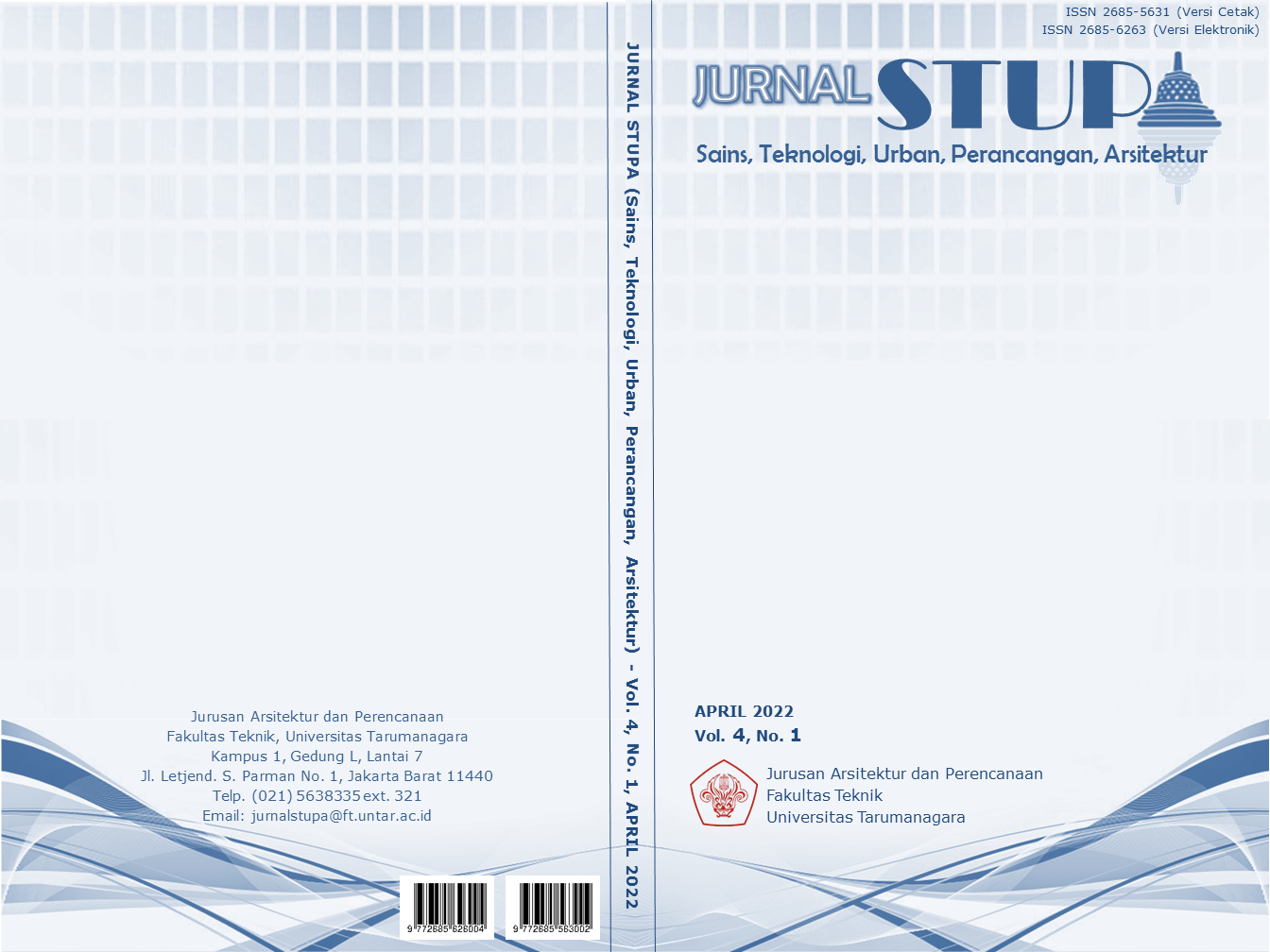PERANCANGAN BALAI MULTI-ETNIK SEBAGAI WADAH UNTUK MEMPERSATUKAN KEMBALI ETNIS DAYAK DAN MADURA DI KAMPUNG PELADIS
Main Article Content
Abstract
Indonesia is a very diverse country, from that diversity there are various ethnic. However, the negative side, is the diversity and differences that can later lead to ethnic conflicts. Just like what happened in Borneo since 1950-2001, where conflicts between Dayak and Madurese ethnic groups repeatedly occurred. Kampung Peladis, which is located in West Borneo, is one proof that there are still borders and boundaries between Dayak and Madurese ethnic groups. Starting from the pattern of settlements, to the daily activities of inter-ethnic groups, and less mingling with each other. Therefore, with the aim of reuniting the two ethnic groups, through rethinking the typology as a design strategy, Rituals of Re-Unite settings so that the two ethnic groups will inevitably meet and communicate with each other at the Multi-Ethnic Hall in Kampung Peladis. Bloomfield once said, reconciliation means finding a way to live side by side with former opponents, to love and forgive them. They need to manage impressions because they "have to forget" the past at all costs, in order to coexist with each other. Thus, the method used is phenomenology as a design approach. Thus, Rituals of Re-Unite: Multi-Ethnic Hall of Kampung Peladis is expected not only to be useful as a forum for assimilation of the two ethnic groups in Kampung Peladis, but also to benefit people's lives.
Keywords: Borneo ; Conflict ; Dayak ; Ethnic ; Madurese
Abstrak
Indonesia merupakan sebuah negara yang sangat majemuk, dari kemajemukan itulah adanya berbagai keragaman etnis dan suku bangsa. Namun jika dilihat dari sisi negatif, dari keberagaman dan perbedaan tersebutlah yang nantinya dapat menimbulkan terjadinya konflik etnis. Layaknya yang terjadi di Kalimantan pada rentang tahun 1950-2001 silam, dimana konflik antaretnik Dayak dan Madura berulang kali terjadi. Kampung Peladis yang terletak di Kalimantan Barat, merupakan salah satu bukti bahwa masih terdapat border dan boundaries antaretnik Dayak dan Madura hingga saat ini. Mulai dari pola permukiman, hingga aktivitas keseharian yang berkelompok antaretnis, dan kurang berbaur antar satu sama lain. Oleh karena itu, dengan tujuan untuk mempersatukan kembali kedua etnis tersebut, melalui rethinking the typology sebagai strategi desain, maka Rituals of Re-Unite mensiasati agar kedua etnis nantinya mau tidak mau bertemu dan saling berkomunikasi di Balai Multi-Etnik Kampung Peladis. Bloomfield pernah mengatakan, rekonsiliasi berarti menemukan cara hidup berdampingan dengan mantan lawan, untuk mencintai dan memaafkan mereka. Mereka perlu mengatur kesan karena mereka "harus melupakan" masa lalu dengan cara apapun, untuk hidup berdampingan satu sama lain. Sehingga, metode yang digunakan yaitu fenomenologi sebagai pendekatan desain. Dengan demikian, Rituals of Re-Unite: Balai Multi-Etnik Kampung Peladis diharapkan tak hanya bermanfaat menjadi wadah pembauran kedua etnis tersebut di Kampung Peladis, namun juga bermanfaat bagi kehidupan masyarakat.
Article Details
References
Alexandra, F. (2014). Analisis Efektivitas Resolusi Konflik Sampit pada Tahun 2001. Yogyakarta: Universitas Gajah Mada.
Halbwachs, M. (1992). On Collective Memory.
Husin, D. (2021). Typology. 13 July 2021, dari Universitas Tarumanagara
Soemardjan, S. (2001). Konflik Antar Suku di Indonesia. Jakarta: Yayasan Ilmu-ilmu Sosial.
Susanto, E. (2007). Revitalisasi Nilai Luhur Tradisi Lokal Madura. KARSA XII (2): 96-103.
Sutanto, A. (2020). Peta Metode Design, e-book, Universitas Tarumanagara.
Tulistyantoro, L. (2005). Makna Ruang pada Tanean Lanjang di Madura. Dimensi Interior III (2): 137-152.
Vidler, A. (1977). The Third Typology. Oppositions 7.
Winata, S. (2021). What is Wrong With Typology?. 15 July 2021, dari Universitas Tarumanagara.
Wiryoprawiro, Z.M. (1986). Arsitektur Tradisional Madura Sumenep Dengan Pendekatan Historis dan Deskriptif. Surabaya: Laboratorium Arsitektur Tradisional FTSP-ITS.



